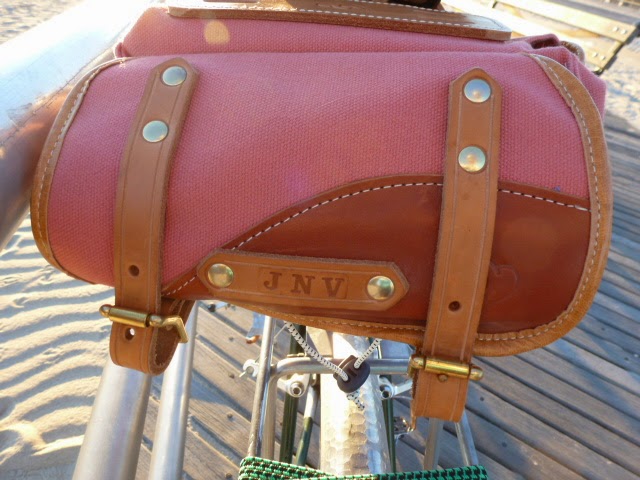A few days ago, I wrote about the excellent (and,
in my opinion, beautiful) randonneur bag Ely Rodriguez of RuthWorks SF made for me.
I photographed it on Vera, my twin-lateral Miss
Mercian mixte. If you looked at the
photos, you probably noticed another bag hanging from the seat rails. I’m going to tell you about it in today’s
post.
As you can probably tell, it’s also Ely’s
work. He made it around the same time he
made the Randonneur bag. So far, I have
used that under-seat bag on three of my bikes:
Vera, Arielle (my Mercian Audax) and Helene (my other Miss
Mercian). It was a great complement to
all of them.
How can I describe it? Well, first of all, I’ll mention its
capacity. I don’t have an exact number,
in cubic inches or liters. But I can say
with confidence that it’s somewhere between the Gilles Berthoud GB 786 saddle bag
and the Carradice Barley: two bags I’ve used.
What that means is that it would probably do you
well for a long day ride, or one that could involve changes of clothing or
necessitate raingear. You could also
carry iPads and small cameras in it; if I were to carry a single-lens reflex
camera with extra lenses and filters, I’d feel more confident with the
Randonneur front bag ( or anything similar) with a small rack underneath.
Now, you could use it alone on a ride like the
ones I’ve mentioned, or on a brevet or a long summer weekend ride for which
you’re packing light.
Well, perhaps I shouldn’t say “packing
light”. “Low-volume” might be more like
it. The bag is very strong, being
solidly constructed of cotton canvas duck and leather. (Ely can make a vegan version of it, if you
prefer.) And it offers a couple of
options for mounting: through the loops
of a saddle like the Brooks B-17, or with a strap around the saddle rails. Of course, you could use both if you’re
carrying a large or heavy load.
Whichever you use, the bag is stabilized by a strap that fastens the bag
to your seatpost, stays or rack rails, depending on the size and configuration
of your bike.
I would imagine that you could also install the
mounting system Gilles Berthoud uses on its largest saddlebag, or fashion your
own version of a decaleur. Speaking of which: I would also imagine that it would work as a
handlebar bag, although I have not tried it myself.
Having said all of that, I will say that you
probably won’t need to go to such lengths:
I simply pulled the long leather strap tight around the body of the bag,
and it stayed snug against the saddle rails on all of my bikes, whether the bag
was packed to, or far from, its capacity.
All in all, I can say: 1.) I am happy with this bag for,
essentially, the same reasons I’m happy with my other RuthWorks bag and, 2.)
This particular bag is a good one to consider if you need something larger than
a basic tool pouch/wedge but don’t want to buy a Bagman, rack or other
hardware. And, also like the other
RuthWorks bags, it’s something to consider if you like a “retro” look and
traditional materials and construction methods, but you want it your way. As
I’ve mentioned in my posts about the other bags he’s made for me, Ely offers a
variety of options (and even does custom designs) as well as materials and
colors.







